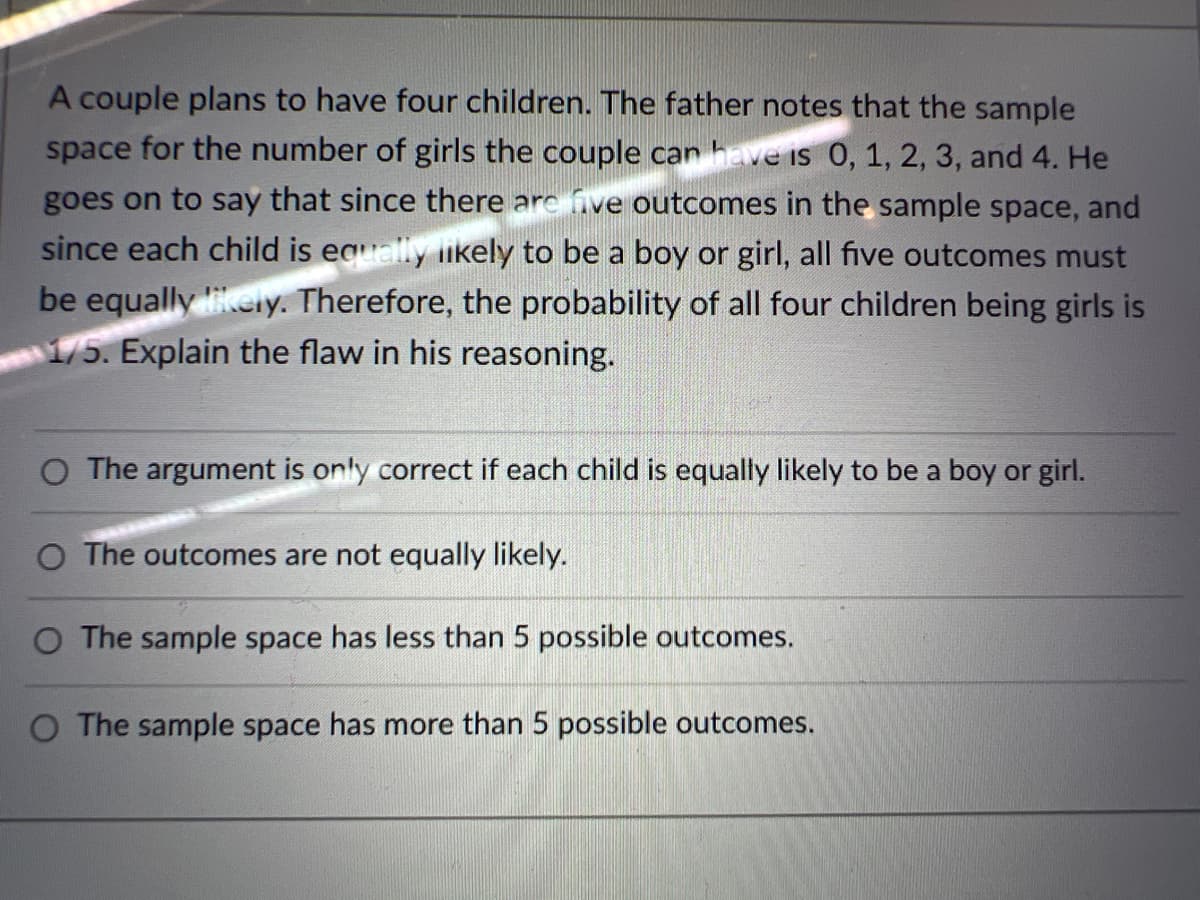A couple plans to have four children. The father notes that the sample space for the number of girls the couple can have is 0, 1, 2, 3, and 4. He goes on to say that since there are five outcomes in the sample space, and since each child is eaually iikely to be a boy or girl, all five outcomes must be equally ely. Therefore, the probability of all four children being girls is 1/5. Explain the flaw in his reasoning. O The argument is only correct if each child is equally likely to be a boy or girl. O The outcomes are not equally likely. O The sample space has less than 5 possible outcomes. O The sample space has more than 5 possible outcomes.
A couple plans to have four children. The father notes that the sample space for the number of girls the couple can have is 0, 1, 2, 3, and 4. He goes on to say that since there are five outcomes in the sample space, and since each child is eaually iikely to be a boy or girl, all five outcomes must be equally ely. Therefore, the probability of all four children being girls is 1/5. Explain the flaw in his reasoning. O The argument is only correct if each child is equally likely to be a boy or girl. O The outcomes are not equally likely. O The sample space has less than 5 possible outcomes. O The sample space has more than 5 possible outcomes.
Holt Mcdougal Larson Pre-algebra: Student Edition 2012
1st Edition
ISBN:9780547587776
Author:HOLT MCDOUGAL
Publisher:HOLT MCDOUGAL
Chapter11: Data Analysis And Probability
Section11.8: Probabilities Of Disjoint And Overlapping Events
Problem 2C
Related questions
Question

Transcribed Image Text:A couple plans to have four children. The father notes that the sample
space for the number of girls the couple can have is 0, 1, 2, 3, and 4. He
goes on to say that since there are five outcomes in the sample space, and
since each child is eaually iikely to be a boy or girl, all five outcomes must
be equally ieiy. Therefore, the probability of all four children being girls is
1/5. Explain the flaw in his reasoning.
The argument is only correct if each child is equally likely to be a boy or girl.
O The outcomes are not equally likely.
O The sample space has less than 5 possible outcomes.
O The sample space has more than 5 possible outcomes.
Expert Solution
This question has been solved!
Explore an expertly crafted, step-by-step solution for a thorough understanding of key concepts.
This is a popular solution!
Trending now
This is a popular solution!
Step by step
Solved in 2 steps with 1 images

Recommended textbooks for you

Holt Mcdougal Larson Pre-algebra: Student Edition…
Algebra
ISBN:
9780547587776
Author:
HOLT MCDOUGAL
Publisher:
HOLT MCDOUGAL

College Algebra (MindTap Course List)
Algebra
ISBN:
9781305652231
Author:
R. David Gustafson, Jeff Hughes
Publisher:
Cengage Learning

Holt Mcdougal Larson Pre-algebra: Student Edition…
Algebra
ISBN:
9780547587776
Author:
HOLT MCDOUGAL
Publisher:
HOLT MCDOUGAL

College Algebra (MindTap Course List)
Algebra
ISBN:
9781305652231
Author:
R. David Gustafson, Jeff Hughes
Publisher:
Cengage Learning